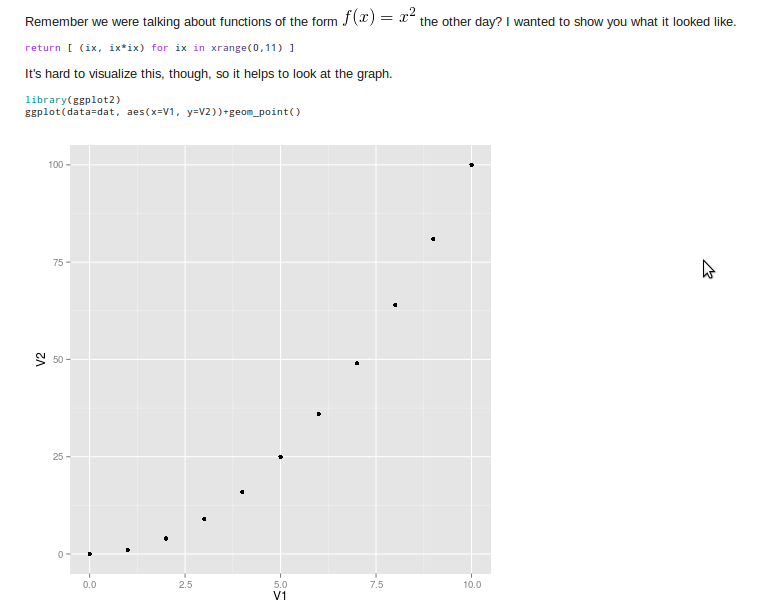Brool brool (n.) : a low roar; a deep murmur or humming
Using mu4e
A thread on Reddit nudged me to try the Emacs mail readers again. I have tried a bunch of them (Wanderlust, Gnus, mew) but found them either too idiosyncratic or painful to use, and for the most part just read my e-mail by logging into Google directly.
However, I just installed mu / mu4e and it works really well — well enough that I prefer reading e-mail in Emacs now, as opposed to just logging into Google mail and reading it there. I ended up archiving about 10 years of mail (approximately 10k of messages) off Gmail and mu can re-index it in seconds.
Installing offlineimap
I used offlineimap to sync everything with Gmail. Steal this configuration and put it in ~/.offlineimaprc (or whatever — but don’t name it .offlineimap, because that will cause errors). For my laptop I added:
maxage = 5 autorefresh = 15… to keep only 5 days of mail and to automatically update it every 15 minutes.
Updated 2016-12-21: Well, scratch that. Unless you want to allow unsafe applications to access your data, you’re going to have to use Oauth.
The instructions are in the comments of this configuration file, but for posterity:
- Go to the Google Developer Console
- Create a new project
- On left bar, select Credentials
- Go to OAuth consent screen and fill in the minimum necessary to submit the form
- Go to Credentials tab and select “Oauth Client ID”
- Choose “other” application type and enter an appropriate name
So that gives you the client ID and the client secret. Wait, you’re not done. You need a refresh token.
- Clone out https://github.com/google/gmail-oauth2-tools.
- Run
python/oauth2.py --generate_oauth2_token --client_id=yourclient --client_secret=yoursecret - This will have you go to your browser to get a verification token that you then enter. That will give you a refresh token.
In your .offlineimaprc, you’ll have something like:
[Repository Personal_Remote]
...
oauth2_client_id = longstringofdigitsandnumbers.apps.googleusercontent.com
oauth2_client_secret = longstringofdigitsandnumbers
oauth2_request_url = https://accounts.google.com/o/oauth2/token
oauth2_refresh_token = 1/longstringofdigitsandnumbers
Installing mu4e
The version of mu4e available in Ubuntu 12.04LTS is really old and throws spurious errors, so you’ll need to build your own. Get mu from github and then rebuild. I needed a few extra libraries in my installation.
sudo apt-get install libglib2.0-dev libgmime-2.6-dev libxapian-dev sudo apt-get install texinfo autoreconf -iInstalling into Emacs
Change into mu4e, do a make / sudo make install. I used pretty much just the longer configuration in the documentation, although I put everything into a deferred load (code below), and there are the following caveats:
- Viewing a message in a browser is handy, so I took the code from the Emacs Wiki.
- I needed to override mu4e-html2text-command because about 10% of HTML messages weren’t rendering.
- The documentation says to set mu4e-view-show-images to show images, but it’s actually mu4e-show-images.
Handy Keys in mu4e
- F — to forward
- C — to compose
- O — opens an attachment in detail view
- aV — views mail in HTML mode
- ji, j!, ja — jump to mailbox. (See mu4e-maildir-shortcuts above).
- mi, m!, ma — move message to mailbox
- V — turn on/off duplicates (handy if you’re looking at All Mail)
- W — turn on/off related messages
- / — narrow the current view via search
- ?, d, m — mark for unread / delete / move
- x — execute deferred marks
Org Mode
One of the neat things about mu4e is the fact that you can send messages built in org-mode, although the current implementation is a little flaky. Unless you do things the right way you’ll often get “Error 70,” and a plain unadorned e-mail will be sent out. Unfortunately, my friends and associates are not yet at that advanced stage of development that they’ll read org-mode format directly.
To use org-mode via compose, you:
- Compose a message
- Run M-x org-mu4e-compose-org-mode (hah, note my alias above)
- And, finally, and most important: you must send the e-mail via \^C \^S only when the cursor is in the header. If you try to send it while the cursor is in the body of the e-mail, it won’t work.
Yeah, not ideal. But hopefully fixable and it isn’t too hard in practice; only a small percentage of the e-mails I send out are rich text.
You may want to change the default formatting options; I found that having a Table of Contents in my e-mails was a bit too pretentious, and the formatting for code blocks left too much white space. Apply the following diff:
diff --git a/mu4e/org-mu4e.el b/mu4e/org-mu4e.el index 44d5ea1..6697486 100644 --- a/mu4e/org-mu4e.el +++ b/mu4e/org-mu4e.el @@ -170,7 +170,9 @@ and images in a multipart/related part." ;; because we probably don't want to export a huge style file (org-export-htmlize-output-type 'inline-css) ;; makes the replies with ">"s look nicer - (org-export-preserve-breaks t) + (org-export-preserve-breaks nil) + ;; turn off table of contents + (org-export-with-toc nil) ;; dvipng for inline latex because MathJax doesn't work in mail (org-export-with-LaTeX-fragments 'dvipng) ;; to hold attachments for inline html imagesOrg Mode Example
And, okay, to be honest it’s not entirely useful in the day to day, but it is pretty neat that if you need to you can send an e-mail via:
Remember we were talking about functions of the form $f(x) = x^2$ the other day? I wanted to show you what it looked like.
#+name: python-data
#+BEGIN_SRC python :exports both :results replace
return [ (ix, ix*ix) for ix in xrange(0,11) ]
#+END_SRC
It's hard to visualize this, though, so it helps to look at the graph.
#+BEGIN_SRC R :var dat=python-data :exports both :results output graphics :file graph.png
library(ggplot2)
ggplot(data=dat, aes(x=V1, y=V2))+geom_point()
#+END_SRC
… to get

Discussion
Comments are moderated whenever I remember that I have a blog.